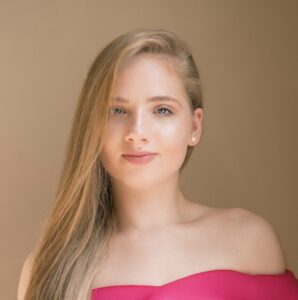|
Ella Nagy
Piano Irish/Hungarian Age: 26 Alexander Siloti Béla Bartók F. Liszt |
Ella Nagy is the first instrumental recipient of the Blackwater Valley Opera Festival RIAM John Pollard Bursary and winner of various competitions in Ireland, such as the RIAM’s Maura Dowdall Concerto Competition in 2019, the RIAM’s Chamber Fest Dublin Prize in 2023 and various Feis Ceoil competitions.
Ella has performed in most of Ireland’s concert venues, most notably, in the National Concert Hall where she received a standing ovation for her performance of Chopin’s Second Piano Concerto with the RTÉ National Symphony Orchestra. Internationally, she has given recitals in the UK, Portugal, Hungary and in New York and Florida. Ella’s performances have been broadcast on RTÉ Lyric FM, Dublin South FM and BBC Radio Ulster. In 2023 Ella recorded both solo and chamber works by Irish composer Jonathan Nangle to feature on his latest album called ‘Surface Patterns ‘. She is fascinated by the connection between Baroque and Contemporary music and for this reason, she studied many of Domenico Scarlatti ‘s sonatas on the harpsichord while simultaneously studying all of Nikolai Kapustin’s Op. 40 Concert Etudes on the piano. Ella is a keen chamber musician and thoroughly enjoys collaborating with both singers and instrumentalists. |
| Programme Notes
I decided to include works from various styles in my programme, starting with a Romantic take on J. S. Bach’s E Minor Prelude, which Siloti arranged in the key of B minor. The first half of the piece focuses on the right-hand semiquaver melody line which is then contrasted in the second half of the work by the melody of the left hand, which is now lifted out and the right-hand figuration is retreating into the background. My second piece is Bartók’s First Romanian Dance which features an overall air of frenziness although the piece does include an evocative middle section before the excitement returns leading on to a triumphant ending. The final piece in my programme is Liszt’s Second Hungarian Rhapsody which conveys two main emotions since the piece is in the form of a ‘csárdás’ a Hungarian dance that usually involves a slow and theatrically melancholic first half and a vivacious second half. The latter section in this rhapsody starts out with the gentle imitiation of the tinkling dulcimer and goes on to a strong finish, in line with Liszt’s virtuosic compositional style. |
|
- Registration Form
- Final Details and Agreement Submission
- Semi-final Programme Details (18-20 mins)
- Welcome to the registration page for the Irish Freemasons Young Musician of the Year Competition.
- Final Programme Details (25-30 mins)
- Course and College/University Details
- Many thanks for submitting your application.

